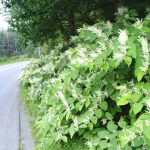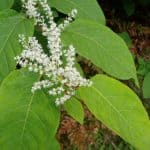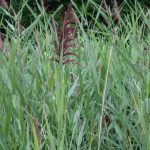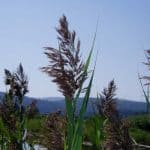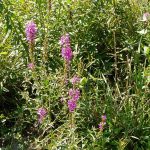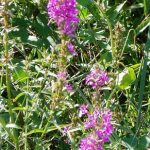ATTACK INVASIVE PLANTS
Invasive, non-native plants crowd out the native plants that indigenous creatures rely on for food, breeding and nesting, shelter, shade and more. Some invasives are quite beautiful – but they throw nature’s balance out of kilter. Local streams have been particularly hard hit.The invaders, including Japanese Knotweed, multiflora rose, barberry and Purple Loosestrife, move quickly and can completely dominate a stream within just a few seasons.
Common Invasive Plants of Concern along Streams in Monroe County, PA
| Common Name | Scientific name | Control Methods* | link to more info | Alternatives to plant* | Vegetation** : click for larger picture | Flower**: click for larger picture |
| Garlic Mustard | Alliaria petiolata | hand removal to roots, cutting 2nd year plants before flowering, herbicides | wild ginger, lady fern, evergreen wood fern, foam flower, creeping phlox, New York fern | 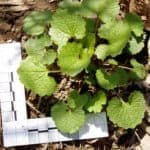 | 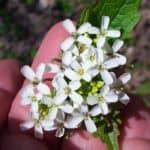 | |
| Japanese Barberry | Berberis thunbergii | small plants pulled by hand (use gloves). Larger bushes should be clipped to base, then base and roots removed with pickax when soil is moist. Herbicides glyphosate and triclopyr also effective. | sweet pepperbush, spicebush, northern bayberry, pasture rose, highbush blueberry, swamp rose | 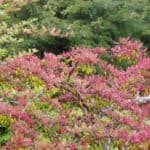 | 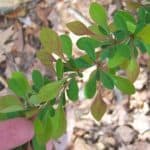 | |
| Japanese Stiltgrass | Microstegium vimineum | identification important to avoid removing natives. Pull (including roots) for small infestations, herbicides for extensive infestations. | plant native grasses | 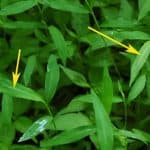 | ||
| Japanese Knotweed | Polygonum cuspidatum | difficult!!! Small infestations pulled by hand, including roots & runners. Herbicides: Glyphosate and triclopyr to cut stems or foliage. | sweet pepperbush, Virginia sweetspire, maleberry, silky dogwood, fragrant or shining sumac | |||
| Multiflora Rose | Rosa multiflora | Young plants pulled by hand. Mature plants controlled through frequent, repeated cutting. Contact and systemic herbicides also effective. Biological controls: rose-rosette disease spread by mites and wasps. | common blackberry, flowering raspberry, pasture rose, swamp rose |  | 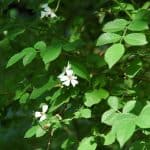 | |
| Common reed | Phragmites australis | Dig up entire plant, including root system or it will re-sprout. | native wetland plants (sedges, grasses and rushes) | |||
| Purple Loosestrife | Lythrum salicaria | Small infestations may be hand pulled, before seed set. For extensive infestations in wetlands us Rodeo. Biological control by beetles most effective for long-term control | Joe Pye weed, cardinal flower, New York ironweed, blazing star or gayfeather, obedient plant, blue vervain | |||
| Spotted Knapweed | Centaurea maculosa (syn. C. biebersteinii) | hand pulled for small infestations (crown & taproot). Herbicides for larger infestations, but may need to be repeated. Be careful to clean tools and shoes to avoid spreading. | plant native vegetation appropriate to site and conditions | 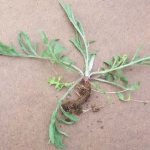 |
* = Information from Swearingen, J., K. Reshetiloff, B. Slattery, and S. Zwicker. 202.
Plant Invaders of Mid-Atlantic Natural Areas. National Park Service and U.S. Fish and Wildlife Service, Washington, D.C. 82 pp.
** = Pictures taken by Jerilyn Jewett-Smith, with an Olympus Stylus 300 digital camera.
OTHER INFORMATIONAL LINKS FOR INVASIVE IDENTIFICATION, ERADICATION AND ALTERNATIVE PLANTINGS. (CAUTION: THESE ARE PDF FILES AND MAY TAKE SOME TIME TO DOWNLOAD.)
USDA INVASIVE PLANTS FIELD AND REFERENCE GUIDE
CITIZEN’S GUIDE TO THE CONTROL OF INVASIVE PLANTS IN WETLAND AND RIPARIAN AREAS

